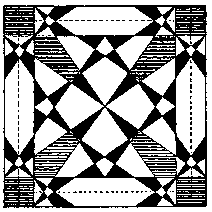
|
Musical Proportions at the Basis of Systems of
Architectural Proportions both Ancient and Modern |
|---|
New Jersey Institute of Technology, Newark, New Jersey, USA
 Throughout
the history of architecture there has been a quest for a system
of proportions that would facilitate the technical and aesthetic
requirements of a design. Such a system would have to ensure
a repetition of a few key ratios throughout the design, have
additive properties that enable the whole to equal the sum of
its parts, and be computationally tractable--in other words,
to be adaptable to the architect's technical means. The repetition
of ratios enables a design to exhibit a sense of unity and harmony
of its parts. Additive properties enable the whole to equal the
sum of its parts in a variety of different ways, giving the designer
flexibility to choose a design that offers the greatest aesthetic
appeal while satisfying the practical considerations of the design.
Architects and designers are most comfortable within the realm
of integers, so any system based on irrational dimensions or
incommensurable proportions should also be expressible in terms
of integers to make it computationally acceptable
Throughout
the history of architecture there has been a quest for a system
of proportions that would facilitate the technical and aesthetic
requirements of a design. Such a system would have to ensure
a repetition of a few key ratios throughout the design, have
additive properties that enable the whole to equal the sum of
its parts, and be computationally tractable--in other words,
to be adaptable to the architect's technical means. The repetition
of ratios enables a design to exhibit a sense of unity and harmony
of its parts. Additive properties enable the whole to equal the
sum of its parts in a variety of different ways, giving the designer
flexibility to choose a design that offers the greatest aesthetic
appeal while satisfying the practical considerations of the design.
Architects and designers are most comfortable within the realm
of integers, so any system based on irrational dimensions or
incommensurable proportions should also be expressible in terms
of integers to make it computationally acceptable
In his book The Theory of Proportion in Architecture, P.H. Scholfield discusses three systems of architectural proportion that meet these requirements: the system of musical proportions used during the Renaissance developed by Leon Battista Alberti, a system used during Roman times, and the Modulor of the twentieth-century architect, Le Corbusier. All of these systems draw upon identical mathematical notions already present in the system of musical proportions. While the Roman system is based on the irrational numbers root-2 and theta=1+ root-2, the Modulor is based on the Golden Mean, phi=(1+ root-5)/2. Both of these systems can also be approximated arbitrarily closely (asymptotically) by integer series, and these integer series can be used to implement the system with negligible error. At the basis of the Roman system is the "law of repetition of ratios" and the geometrical construction known as the "Sacred Cut." An analysis of the Medici Chapel illustrates that both the law of repetition and the Sacred Cut are geometric expressions of the additive properties of the Roman systems and ensure the presence of musical proportions in a design. The discussion concludes with Ezra Ehrenkrantz's system of "modular coordination" based on both musical proportions of Alberti and Fibonacci numbers.
ABOUT THE AUTHOR
Jay
Kappraff holds a Ph.D.
from the Courant Institute of Mathematical Science at New York
University. He is an associate professor of mathematics at the
New Jersey Institute of Technology where he has developed a course
in the mathematics of design for architects and computer scientists.
Prior to that, he taught at the Cooper Union College in New York
City and held the position of aerospace engineer at NASA. He
has published numerous articles on such diverse subjects as fractals,
phyllotaxy, design science, plasma physics, passive solar heating
and aerospace engineering. He has also lectured widely on the
relationships between art and science. He is the author of Connections:
The Geometric Bridge Between Art and Science. His new book,
Mathematics Beyond Measure: A Random Walk Through Nature,
Myth and Number, is to be published soon.
|
Jay Kappraff, "Musical Proportions at the Basis of Systems of Architectural Proportions both Ancient and Modern", pp. 115-133 in Nexus: Architecture and Mathematics, ed. Kim Williams, Fucecchio (Florence): Edizioni dell'Erba, 1996. http://www.nexusjournal.com/conferences/N1996-Kappraff.html |
|
|
|
|
